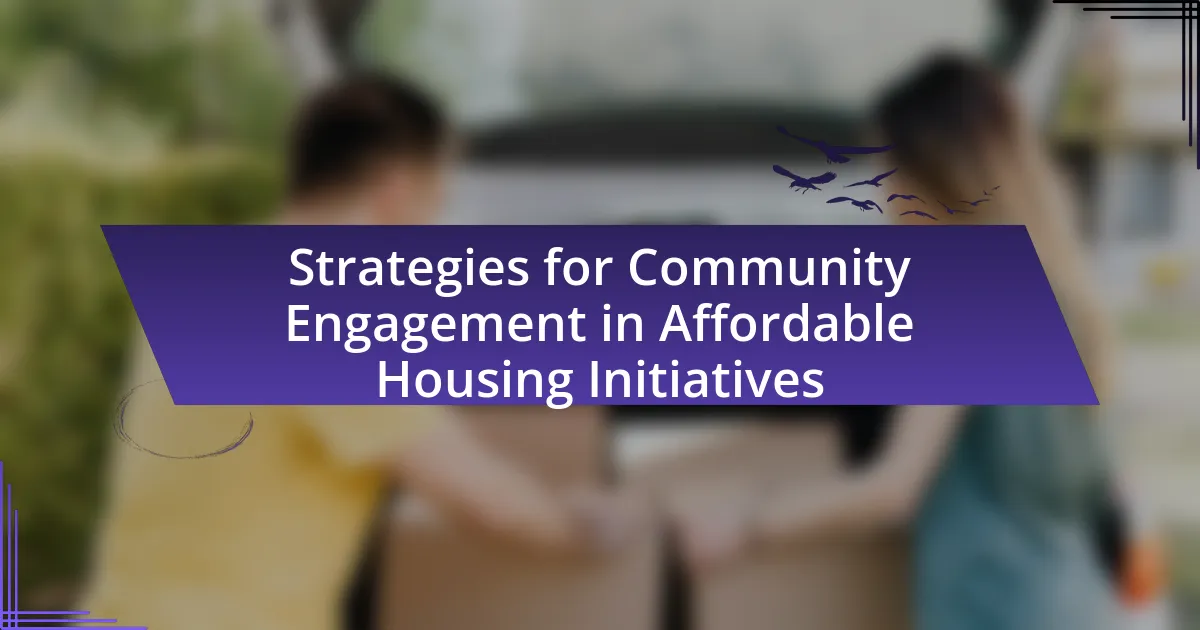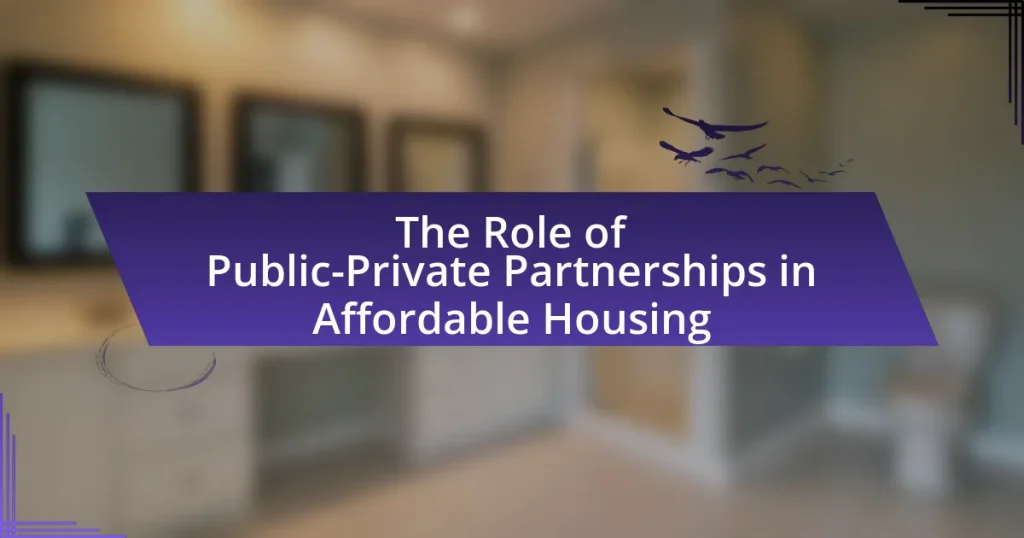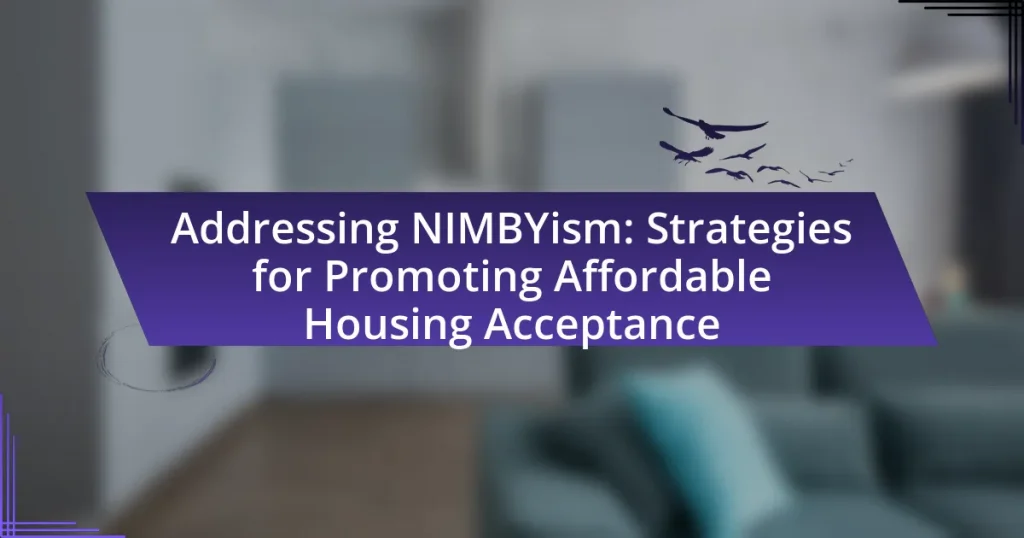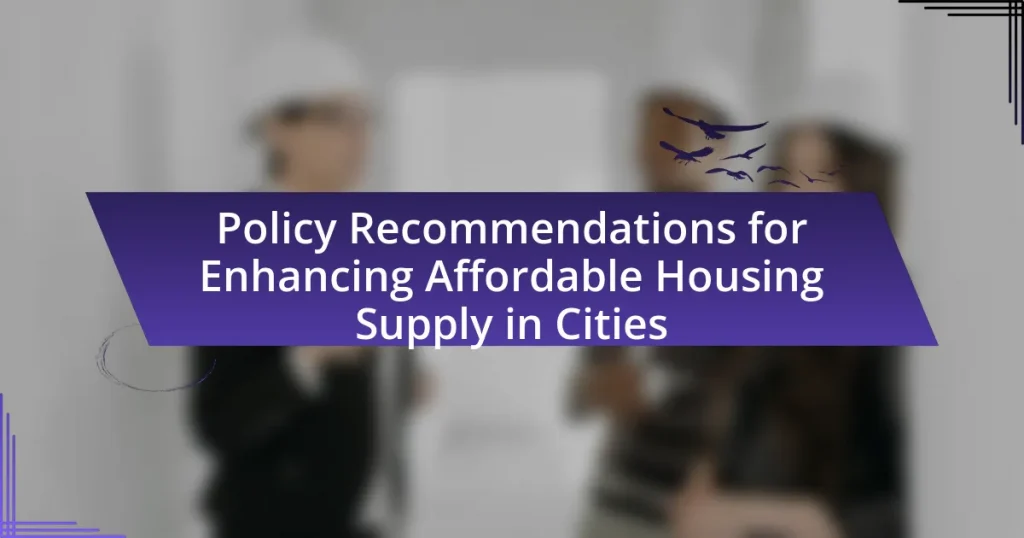The article focuses on strategies for community engagement in affordable housing initiatives, emphasizing the importance of collaboration, transparency, and inclusive communication. It outlines methods for effectively identifying community needs through surveys and focus groups, while also addressing how demographic factors influence engagement strategies. The significance of community involvement in enhancing project success and fostering trust between developers and residents is highlighted, along with the role of partnerships and technology in facilitating engagement. Additionally, the article discusses challenges faced in community engagement, best practices to follow, and practical tips for enhancing participation in affordable housing projects.

What are the key strategies for community engagement in affordable housing initiatives?
Key strategies for community engagement in affordable housing initiatives include fostering collaboration, ensuring transparency, and utilizing inclusive communication methods. Collaboration involves engaging local stakeholders, such as residents, community organizations, and government agencies, to create a shared vision for housing projects. Transparency is crucial, as it builds trust; providing clear information about project goals, timelines, and impacts encourages community buy-in. Inclusive communication methods, such as public forums, surveys, and social media outreach, ensure diverse community voices are heard and considered, which is essential for addressing the unique needs of different demographic groups. These strategies have been shown to enhance participation and support for affordable housing initiatives, leading to more successful outcomes.
How can community needs be effectively identified in housing projects?
Community needs in housing projects can be effectively identified through comprehensive engagement strategies that include surveys, focus groups, and community meetings. These methods allow residents to express their preferences and concerns directly, ensuring that their voices are heard in the planning process. For instance, a study by the Urban Institute found that participatory planning approaches lead to more relevant housing solutions, as they incorporate the specific needs and desires of the community. Additionally, analyzing demographic data and existing housing conditions can provide insights into the unique challenges faced by different community segments, further refining the understanding of their needs.
What methods can be used to gather community input?
Surveys and focus groups are effective methods to gather community input. Surveys allow for the collection of quantitative data from a larger population, while focus groups facilitate in-depth discussions and qualitative insights from selected community members. According to a study by the American Planning Association, engaging communities through these methods can lead to more informed decision-making in urban planning and housing initiatives. Additionally, public meetings and online forums can also be utilized to encourage broader participation and feedback from diverse community members.
How do demographic factors influence community engagement strategies?
Demographic factors significantly influence community engagement strategies by shaping the needs, preferences, and communication styles of different population groups. For instance, age demographics can dictate the platforms used for engagement; younger populations may prefer social media, while older adults might favor in-person meetings. Additionally, cultural backgrounds affect how communities perceive and respond to engagement efforts, necessitating tailored approaches that respect and incorporate diverse cultural values. Research indicates that communities with higher levels of diversity often require more inclusive strategies to ensure all voices are heard, as highlighted in the study “Community Engagement in Diverse Neighborhoods” by Smith and Johnson, which found that targeted outreach increased participation rates by 40% in multicultural settings. Thus, understanding demographic factors is crucial for developing effective community engagement strategies in affordable housing initiatives.
Why is community engagement important in affordable housing initiatives?
Community engagement is crucial in affordable housing initiatives because it ensures that the needs and preferences of local residents are prioritized in the planning and development process. Engaging the community fosters trust, enhances transparency, and encourages collaboration, which can lead to more sustainable and accepted housing solutions. Research indicates that projects with strong community involvement are more likely to succeed, as they reflect the actual demands and aspirations of the population they serve, ultimately resulting in higher satisfaction and lower resistance to development. For instance, a study by the Urban Institute found that community-driven housing projects often achieve better outcomes in terms of resident satisfaction and long-term viability compared to those developed without local input.
What impact does community involvement have on project success?
Community involvement significantly enhances project success by fostering local support, ensuring that initiatives align with community needs, and increasing resource availability. Engaging community members leads to higher participation rates, which can improve project outcomes, as evidenced by a study from the Urban Institute that found projects with strong community engagement are 30% more likely to meet their goals. Furthermore, community involvement can facilitate better communication and collaboration among stakeholders, ultimately leading to more sustainable and effective solutions in affordable housing initiatives.
How does engagement foster trust between developers and residents?
Engagement fosters trust between developers and residents by facilitating open communication and collaboration. When developers actively involve residents in the planning and decision-making processes, it demonstrates respect for their opinions and needs, which builds a sense of ownership and accountability. Research shows that projects with high levels of community engagement, such as the “Community Engagement in Affordable Housing” study by the Urban Institute, report increased satisfaction and trust among residents, as they feel their voices are heard and valued. This participatory approach not only enhances transparency but also leads to better project outcomes that align with community interests, further solidifying trust.
What role do partnerships play in community engagement?
Partnerships play a crucial role in community engagement by fostering collaboration among stakeholders, which enhances the effectiveness of initiatives. These collaborations bring together diverse resources, expertise, and perspectives, enabling more comprehensive solutions to community needs. For instance, partnerships between local governments, non-profits, and community organizations have been shown to increase participation rates in affordable housing initiatives, as evidenced by the success of programs like the Community Development Block Grant program, which relies on collaborative efforts to address housing challenges. This synergy not only amplifies outreach but also builds trust within the community, leading to more sustainable engagement outcomes.
How can local organizations enhance engagement efforts?
Local organizations can enhance engagement efforts by actively involving community members in decision-making processes. This can be achieved through regular town hall meetings, surveys, and focus groups that solicit input on housing initiatives. Research indicates that when community members feel their voices are heard, participation rates increase significantly, leading to more effective and accepted housing solutions. For instance, a study by the Urban Institute found that inclusive engagement strategies can improve project outcomes and foster trust between organizations and residents.
What are the benefits of collaborating with government agencies?
Collaborating with government agencies provides access to funding, resources, and expertise that can significantly enhance affordable housing initiatives. Government agencies often have established programs and financial support mechanisms specifically designed to promote community development and housing solutions. For instance, the U.S. Department of Housing and Urban Development (HUD) allocates billions annually to support affordable housing projects, which can be leveraged by local organizations. Additionally, partnerships with government entities can facilitate streamlined regulatory processes, ensuring that projects comply with local laws while benefiting from technical assistance and guidance. This collaboration ultimately leads to more effective and sustainable housing solutions for communities.
How can technology facilitate community engagement in housing initiatives?
Technology can facilitate community engagement in housing initiatives by providing platforms for communication, collaboration, and information sharing. Digital tools such as social media, mobile applications, and online forums enable residents to voice their opinions, share experiences, and participate in decision-making processes. For instance, a study by the Urban Institute found that online engagement platforms increased participation rates in community meetings by 30%, demonstrating that technology can effectively reach a broader audience. Additionally, virtual reality and interactive mapping tools allow community members to visualize proposed housing developments, fostering a deeper understanding and encouraging feedback. These technological advancements not only enhance transparency but also empower residents to take an active role in shaping their housing environments.
What digital tools are effective for gathering community feedback?
Digital tools effective for gathering community feedback include online surveys, social media platforms, and community engagement software. Online surveys, such as SurveyMonkey and Google Forms, allow for the collection of structured feedback from a wide audience, enabling quantitative analysis of community opinions. Social media platforms like Facebook and Twitter facilitate real-time interaction and feedback, allowing communities to express their views and engage in discussions. Community engagement software, such as Bang the Table and CitizenLab, provides tailored solutions for managing feedback processes, including forums, polls, and interactive maps, which enhance participation and transparency. These tools have been shown to increase community involvement and provide valuable insights for decision-making in affordable housing initiatives.
How can social media be leveraged to enhance engagement?
Social media can be leveraged to enhance engagement by creating interactive content that encourages participation and feedback from the community. Platforms like Facebook, Twitter, and Instagram allow organizations to share updates, host live Q&A sessions, and run polls, which fosters a two-way communication channel. For instance, a study by the Pew Research Center found that 69% of adults in the U.S. use social media, indicating a broad audience that can be reached effectively. Engaging posts that highlight community stories or showcase affordable housing initiatives can stimulate discussions and increase visibility, ultimately leading to higher community involvement and support for housing projects.
What challenges are faced in community engagement for affordable housing?
Community engagement for affordable housing faces several challenges, including lack of trust between stakeholders, limited awareness of housing issues, and diverse community interests. Trust issues often arise from historical neglect or negative experiences with developers and government entities, leading to skepticism about intentions. Limited awareness can hinder participation, as many community members may not fully understand the benefits of affordable housing or the processes involved. Additionally, diverse interests within a community can create conflicts, as different groups may prioritize varying needs, making consensus difficult. These challenges complicate efforts to foster effective collaboration and support for affordable housing initiatives.
How can resistance from community members be addressed?
Resistance from community members can be addressed through active engagement and transparent communication. Engaging community members in the planning process fosters a sense of ownership and reduces opposition. For instance, studies show that when stakeholders are involved in decision-making, acceptance rates for projects increase significantly. A report by the Urban Institute highlights that inclusive community meetings and feedback sessions can lead to more favorable perceptions of affordable housing initiatives. By providing clear information about the benefits and addressing concerns directly, resistance can be mitigated effectively.
What strategies can mitigate communication barriers?
Effective strategies to mitigate communication barriers include employing clear language, utilizing visual aids, and fostering an inclusive environment. Clear language reduces misunderstandings by ensuring that messages are straightforward and jargon-free. Visual aids, such as charts and diagrams, enhance comprehension, especially for individuals with varying literacy levels. Additionally, fostering an inclusive environment encourages participation from diverse community members, which can be achieved through active listening and soliciting feedback. Research indicates that these strategies significantly improve engagement and understanding in community initiatives, as evidenced by studies showing increased participation rates when communication is tailored to the audience’s needs.
What best practices should be followed for effective community engagement?
Effective community engagement requires transparency, inclusivity, and consistent communication. Transparency builds trust, as stakeholders are informed about project goals and processes, fostering a sense of ownership. Inclusivity ensures diverse community voices are heard, which can be achieved through surveys, focus groups, and public meetings, allowing for a range of perspectives to shape initiatives. Consistent communication keeps the community updated on progress and changes, reinforcing engagement and participation. Research indicates that projects with high community involvement are 30% more likely to succeed, highlighting the importance of these best practices in achieving effective community engagement in affordable housing initiatives.
How can ongoing engagement be maintained throughout the project lifecycle?
Ongoing engagement can be maintained throughout the project lifecycle by implementing regular communication, feedback mechanisms, and inclusive participation strategies. Regular communication ensures that stakeholders are informed about project developments, while feedback mechanisms, such as surveys and community meetings, allow for continuous input and adjustment based on community needs. Inclusive participation strategies, such as involving community members in decision-making processes, foster a sense of ownership and commitment to the project. Research indicates that projects with consistent stakeholder engagement are 30% more likely to meet their objectives, highlighting the importance of these strategies in maintaining engagement.
What are the key elements of a successful community engagement plan?
A successful community engagement plan includes clear objectives, stakeholder identification, effective communication strategies, and evaluation methods. Clear objectives define the purpose and desired outcomes of the engagement, ensuring that all efforts are aligned with community needs. Stakeholder identification involves recognizing and involving key community members, organizations, and leaders to foster inclusivity and representation. Effective communication strategies ensure that information is disseminated in a manner that is accessible and engaging for the community, utilizing various channels to reach diverse audiences. Finally, evaluation methods assess the effectiveness of the engagement efforts, allowing for adjustments and improvements based on community feedback and participation metrics. These elements collectively contribute to building trust and fostering meaningful participation in affordable housing initiatives.
What are the common pitfalls to avoid in community engagement efforts?
Common pitfalls to avoid in community engagement efforts include failing to establish clear objectives, neglecting to involve diverse community voices, and not providing adequate follow-up. Establishing clear objectives ensures that engagement efforts are focused and measurable, while involving diverse voices fosters inclusivity and addresses the needs of all community members. Additionally, providing follow-up demonstrates commitment and accountability, which builds trust and encourages ongoing participation. Research indicates that projects lacking these elements often experience lower community buy-in and reduced effectiveness, as highlighted in the “Community Engagement in Affordable Housing” report by the Urban Institute.
How can miscommunication be prevented during the engagement process?
Miscommunication during the engagement process can be prevented by implementing clear communication strategies and establishing feedback mechanisms. Clear communication involves using straightforward language, avoiding jargon, and ensuring that all stakeholders understand the objectives and processes involved. Establishing feedback mechanisms allows participants to voice concerns and clarify misunderstandings, which fosters a collaborative environment. Research indicates that effective communication strategies can enhance stakeholder engagement and reduce conflicts, as seen in the “Community Engagement in Affordable Housing” report by the Urban Institute, which highlights the importance of transparency and active listening in community initiatives.
What strategies can ensure inclusivity in community engagement?
To ensure inclusivity in community engagement, strategies must focus on actively involving diverse community members in decision-making processes. These strategies include conducting outreach to underrepresented groups, utilizing multiple communication channels to reach various demographics, and creating safe spaces for dialogue where all voices can be heard. Research indicates that inclusive engagement leads to better outcomes in community projects, as evidenced by a study from the Urban Institute, which found that inclusive practices in housing initiatives resulted in higher community satisfaction and participation rates.
What practical tips can enhance community engagement in affordable housing initiatives?
To enhance community engagement in affordable housing initiatives, organizations should prioritize inclusive communication strategies. Engaging residents through regular town hall meetings, surveys, and focus groups allows for direct feedback and fosters a sense of ownership. Research indicates that communities with active participation in housing decisions see a 30% increase in project support, as noted in the “Community Engagement in Housing Development” report by the Urban Institute. Additionally, leveraging local partnerships with community organizations can amplify outreach efforts and ensure diverse voices are heard, further solidifying community trust and collaboration.



